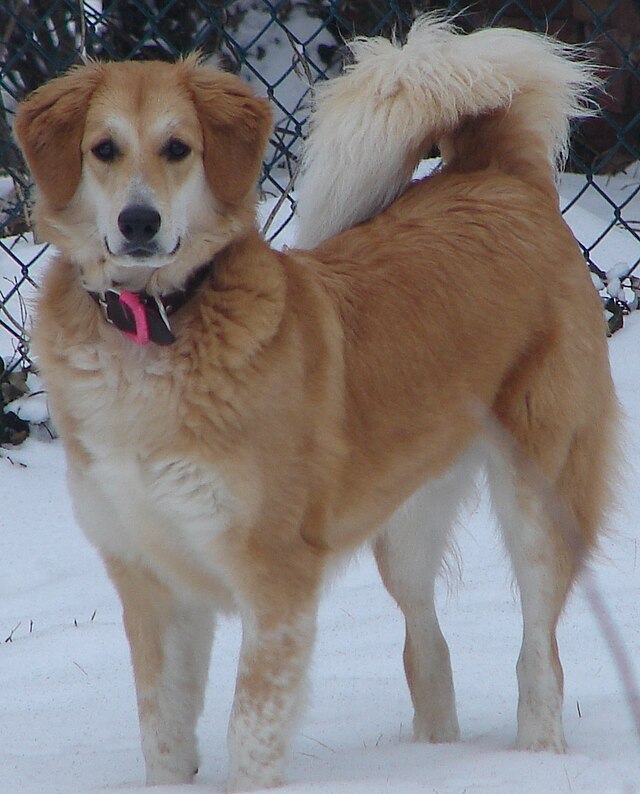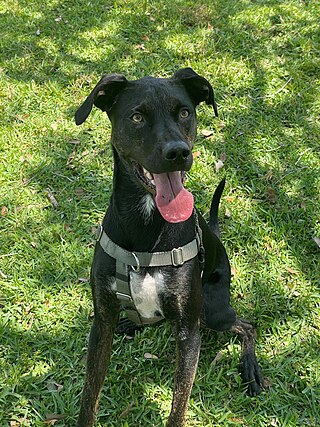Mongrel
Dog of mixed breeds From Wikipedia, the free encyclopedia
A mongrel, mutt, or mixed-breed dog is a dog that does not belong to one officially recognized breed, including those that result from intentional breeding. Although the term mixed-breed dog is sometimes preferred, many mongrels have no known purebred ancestors.
This article needs additional citations for verification. (August 2019) |

Crossbreed dogs, and "designer dogs", while also a mix of breeds, differ from mongrels in being intentionally bred. At other times, the word mongrel has been applied to informally purpose-bred dogs such as curs, which were created at least in part from mongrels, especially if the breed is not officially recognized.
Although mongrels are viewed as of less commercial value than intentionally bred dogs, they are thought to be less susceptible to genetic health problems associated with inbreeding (based on the theory of heterosis), and have enthusiasts and defenders who prefer them to intentionally bred dogs.
Estimates place the prevalence of mongrels at 150 million animals worldwide.[1]
Terminology
Summarize
Perspective
Mixed-breed and crossbreed
In the United States, the term mixed-breed is a favored synonym over mongrel among people who wish to avoid negative connotations associated with the latter term.[2] The implication that such dogs must be a mix of defined breeds may stem from an inverted understanding of the origins of dog breeds. Purebred dogs have been, for the most part, artificially created from random-bred populations by human selective breeding with the purpose of enhancing desired physical, behavioral, or temperamental characteristics. Dogs that are not purebred are not necessarily a mix of such defined breeds.[3] Therefore, among some experts and fans of such dogs, mongrel is still the preferred term.[4][5][6]
Dog crossbreeds, sometimes called designer dogs, also are not members of a single recognized breed. Unlike mixed-breeds, crossbreed dogs are often the product of artificial selection – intentionally created by humans, whereas the term mongrel specifically refers to dogs that develop by natural selection, without the planned intervention of humans.

Regional and slang terms
The words cur,[7] tyke,[8] mutt, and mongrel[9] are used, sometimes in a derogatory manner. There are also regional terms for mixed-breed dogs. In the United Kingdom, mongrel is the unique technical word for a mixed-breed dog. North Americans generally prefer the term mix or mixed-breed. Mutt[10] is also commonly used in the United States and Canada. Some American registries and dog clubs that accept mixed-breed dogs use the term All-American to describe mixed-breed dogs.[11]
There are also names for mixed-breeds based on geography, behavior, or food. In Hawaii, mixes are referred to as poi dogs, although they are not related to the extinct Hawaiian Poi Dog. In the Bahamas and the Turks and Caicos Islands, the common term is potcake dogs (referring to the table scraps they are fed). In South Africa, the tongue-in-cheek expression pavement special is sometimes used as a description for a mixed-breed dog. In Trinidad and Tobago, these mixed dogs are referred to as pot hounds (pothong). In Serbia, a similar expression is prekoplotski avlijaner (over-the-fence yard-dweller). In Russia, a colloquial term дворняга (yard-dweller) is used most commonly. In the Philippines, mixed-breed street dogs are often called askal, a Tagalog-derived contraction of asong kalye (”street dog"), while in Singapore, they are known as Singapore Specials.[12] In Puerto Rico, they are known as satos; in Venezuela they are called yusos or cacris, the latter being a contraction of the words callejero criollo (literally, street creole, as street dogs are usually mongrels); and in Chile and Bolivia, they are called quiltros. In Costa Rica, it is common to hear the word zaguate, a term originating from a Nahuatl term, zahuatl, that refers to the disease called scabies. In the rural southern United States, a small hunting dog is known as a feist. In Yucatan Peninsula, Mexico, they are called "malix" (ma.liʃ), meaning "no breed" in mayan language.
Slang terms are also common. Heinz 57, Heinz, or Heinz Hound is often used for dogs of uncertain ancestry, in a playful reference to the "57 Varieties" slogan of the H. J. Heinz Company. In some countries, such as Australia, bitsa (or bitzer) is sometimes used, meaning "bits o' this, bits o' that". In Brazil and the Dominican Republic, the name for mixed-breed dogs is vira-lata (trash-can tipper) because of homeless dogs who knock over trash cans to reach discarded food. In Newfoundland, a smaller mixed-breed dog is known as a cracky, hence the colloquial expression "saucy as a cracky" for someone with a sharp tongue. In Sweden these dogs might be humorously referred to as a gatu korsning, which translates to intersection, but literally to 'street crossing'.[13]
Determining ancestry
Summarize
Perspective

Guessing a mixed-breed's ancestry can be difficult even for knowledgeable dog observers, because mixed-breeds have much more genetic variation than purebreds. For example, two black mixed-breed dogs might each have recessive genes that produce a blond coat and, therefore, produce offspring looking unlike their parents.
Starting in 2007, genetic analysis[14] has become available to the public. The companies claim their DNA-based diagnostic test can genetically determine the breed composition of mixed-breed dogs. These tests are still limited in scope because only a small number of the hundreds of dog breeds have been validated against the tests, and because the same breed in different geographical areas may have different genetic profiles. The tests do not test for breed purity, but for genetic sequences that are common to certain breeds. With a mixed-breed dog, the test is not proof of purebred ancestry, but rather an indication that those dogs share common ancestry with certain purebreds. The American Kennel Club does not recognize the use of DNA tests to determine breed.[15][16]
Many newer dog breeds can be traced back to a common foundational breed, making them difficult to separate genetically. For example, Labrador Retrievers, Flat-coated Retrievers, Chesapeake Bay Retrievers, and Newfoundland dogs share a common ancestry with the St. John's water dog – a now-extinct naturally occurring dog landrace from the island of Newfoundland.
Health
Summarize
Perspective

The theory of hybrid vigor suggests that as a group, dogs of varied ancestry will be generally healthier than their purebred counterparts. In purebred dogs, intentionally breeding dogs of very similar appearance over several generations produces animals that carry many of the same alleles, some of which are detrimental. If the founding population for the breed was small, then the genetic diversity of that particular breed may be small for quite some time.
When humans select certain dogs for new breeds, they artificially isolate that group of genes and cause more copies of that gene to be made than might have otherwise occurred in nature. The population is initially more fragile because of the lack of genetic diversity. If the dog breed is popular, and the line continues, over hundreds of years diversity increases due to mutations and occasional out-breeding. This is why some of the very old breeds are more stable. One issue is when certain traits found in the breed standard are associated with genetic disorders. The artificial selective force favors the duplication of the genetic disorder because it comes with a desired physical trait.[17][18] The genetic health of hybrids tends to be higher.[19] Healthy traits have been lost in many purebred dog lines because many breeders of showdogs are more interested in conformation – the physical attributes of the dogs in relation to the breed standard – than in the health and working temperament for which the dog was originally bred.[20]
Populations are vulnerable when the dogs bred are closely related. Inbreeding among purebreds has exposed various genetic health problems not always readily apparent in less uniform populations. Mixed-breed dogs are more genetically diverse due to the more haphazard nature of their parents' mating. The offspring of such matings might be less likely to express certain genetic disorders because there might be a decreased chance that both parents carry the same detrimental recessive alleles, but some deleterious recessives occur across many seemingly unrelated breeds, and therefore merely mixing breeds is no guarantee of genetic health. When two poor specimens are bred, the offspring could inherit the worst traits of both parents. This is commonly seen in dogs that came from puppy mills.[21]
Several studies have shown that mixed-breed dogs have a health advantage over purebred dogs. A German study finds that "mongrels require less veterinary treatment".[22] Studies in Sweden have found that "Mongrel dogs are less prone to many diseases than the average purebred dog"[23] and, when referring to death rates, that "mongrels were consistently in the low risk category".[24] Data from Denmark also suggest that mixed breeds have greater longevity on average compared to purebreds. [25] A British study showed similar results, but a few breeds (notably Jack Russell Terriers, Miniature Poodles and Whippets) lived longer than mixed breeds.[26]
In one study, the effect of breed on longevity in the pet dog was analyzed using mortality data from 23,535 pet dogs. The data were obtained from North American veterinary teaching hospitals. The median age at death was determined for purebred and mixed-breed dogs of different body weights. Within each body weight category, the median age at death was lower for purebred dogs compared with mixed-breed dogs. The median age at death was "8.5 years for all mixed breed dogs, and 6.7 years for all pure breed dogs" in the study.[27]
In 2013, a study found that mixed breeds live on average 1.2 years longer than purebreds, and that increasing body weight was negatively correlated with longevity (i.e. the heavier the dog, the shorter its lifespan).[28] Another study published in 2019 confirmed this 1.2 year difference in lifespan for mixed-breed dogs, and further demonstrated negative impacts of recent inbreeding and benefits of occasional outcrossing for lifespan in individual dogs.[29]
Studies that have been done in the area of health show that mixed-breeds on average are both healthier and longer-lived than their purebred relations. This is because current accepted breeding practices within the pedigreed dog community result in a reduction in genetic diversity, and can result in physical characteristics that lead to health issues.[30]
Studies have shown that crossbreed dogs have a number of desirable reproductive traits. Scott and Fuller found that crossbreed dogs were superior mothers compared to purebred mothers, producing more milk and giving better care. These advantages led to a decreased mortality in the offspring of crossbreed dogs.[31]
Gallery
Examples of mongrels
- DNA sequencing showed this mongrel dog to be a mix of Labrador Retriever, Bull Mastiff, Chow, Australian Cattle Dog, Corgi, and Pit Bull.
- Spinone Italiano–German Shepherd mixed-breed dog
- Australian Shepherd–Border Collie mixed-breed dog
- Although these mongrels are littermates of an Australian Shepherd mother, they look quite different and neither exactly resembles that breed.
- A Mexican street mutt
- Mongrel of visually indeterminable lineage
- Mid-size Brazilian mixed-breed dog
- A two-year-old dog of unknown parentage, possibly Australian Shepherd and Golden Retriever
- Ukrainian mixed-breed dog
- Askal also known as Aspin is a street dog that is commonly seen in the Philippines
- A mongrel dog with German Shepherd, Shetland Sheepdog, American Staffordshire Terrier, Chow Chow heritage and others
See also
References
External links
Wikiwand - on
Seamless Wikipedia browsing. On steroids.












